#1965 Jaguar
Explore tagged Tumblr posts
Text







Jaguar E-Type Series 1 4.2 Coupé Prototype, 1965, by Frua. A project by British racing driver John Coombs to offer a bespoke version of the E-type. After a chance meeting with Italian coachbuilder Peitro Frua, they agreed a series of trim modifications that would be manufactured by Frua in Turin and then fitted by Coombs at his workshop in the UK. In addition to the Frua-designed nose and rear bumper Combs had the head ported and added a high ratio back axle with suspension upgrades. It was presented at the 1966 Geneva Motor Show and at Earls Court but despite receiving orders Combs cancelled the project on cost grounds so the prototype remained a one-off. It was sold recently in the UK
sales listing
#Jaguar#Jaguar E-Type#Frua#Pietro Frua#coachbuilt#prototype#one-off#Jaguar E-Type Series 1 4.2 Coupé#Jaguar E-Type FHC#straight 6#DOHC#John Coombs#1965#Geneva Motor Show#bespoke#wire wheels
257 notes
·
View notes
Text
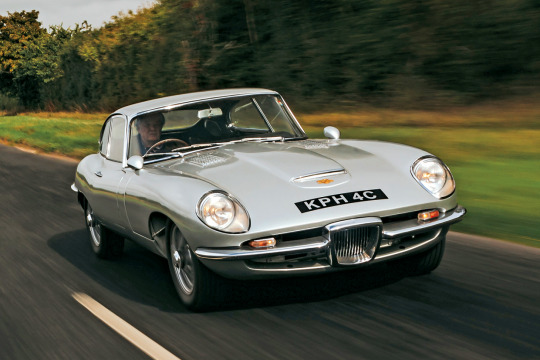


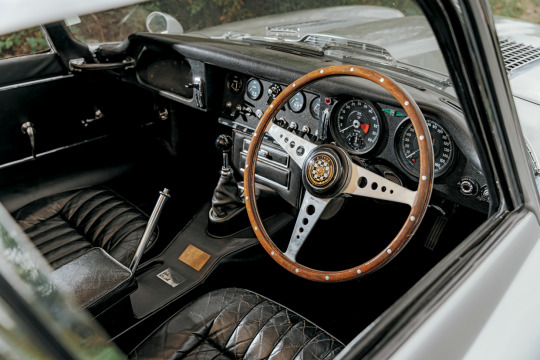
1965 Frua Jaguar E-Type
My tumblr-blogs: https://www.tumblr.com/blog/germancarssince1946 & https://www.tumblr.com/blog/frenchcarssince1946 & https://www.tumblr.com/blog/englishcarssince1946 & https://www.tumblr.com/blog/italiancarssince1946 & https://www.tumblr.com/blog/japanesecarssince1947
13 notes
·
View notes
Text

Jane Birkin hops in her Jaguar E-Type, 1965
683 notes
·
View notes
Text

Jane Birkin monte dans sa Jaguar E-Type 1965. - source Moto Vitelloni - Wheels n' wings.
171 notes
·
View notes
Text

1965 Jaguar E-Type Series ★彡𝓛𝓓ミ★
61 notes
·
View notes
Text






Red, White & Royal Blue (2023) directed by Matthew López
Favourite smaller things part 3 (part 1, part 2, part 4):
1. Henry noticing Alex's anxiety, so he compliments his taste in perfume to distract him 2.Henry's car is a Jaguar Type-E used in the 1965 Bond movie - his dad played James Bond before he married into the Royal family 3. Alex's adorable nose scrunch 4. Henry's lips #nothing else 5. Henry streching his arms out as soon as he looks at Alex 6.Casey McQuiston's (the author of the book) cameo
#red white and royal blue#rwrb#prince henry fox mountchristen windsor#prince henry of wales#prince henry rwrb#nicholas galitzine#alex claremont diaz#alexander claremont diaz#taylor zakhar perez#firstprince#rwrbedit
444 notes
·
View notes
Text

1965 Jaguar XKE SI 4.2 Roadster.
36 notes
·
View notes
Text

The 1965 Lotus-Ford that Jimmy Clark drove to the 1965 Indianapolis 500 Championship.


Jim Clark was a 2 time F1 World Champion and Indy 500 Champion
Jim Clark died because he was in the wrong place at the wrong time. On 7 April 1968, Clark should have been at Brands Hatch giving the DFV-engined Ford F3L its debut in the BOAC 500 sports car race. But he had been double-booked that weekend, and instead spent it at Hockenheim in Germany for a big European F3 meeting where Lotus was fielding its works team, to oblige sponsors Firestone.
Clark was a sheep farmer from the Scottish Borders who had started competing in sprints in his Sunbeam Mk3 saloon in 1956. He won his first event. He raced friend Ian Scott Watson’s DKW Sonderklasse and Porsche 356 1600 Super before graduating to a Jaguar D-type run by the Border Reivers team.
In 1958 Scott Watson bought one of the first Lotus Type 14 Elites, and at the Boxing Day Brands Hatch race meeting Clark had Lotus founder Colin Chapman in his own Elite all but beaten, until a backmarker spun in front of him.
Clark’s smoothness and mechanical sympathy meant he could often get a Lotus to last a race distance where other drivers could not
By 1960 Clark was a Lotus F1 driver, and he won his first championship race at Spa in 1962. It was one of three wins that year, leaving him in contention for the world championship at the final race of the season in South Africa – but his Lotus failed him, and BRM driver Graham Hill was crowned champion.
There was no mistake the following year. Clark won seven of the 10 races in 1963 – the most any driver had won in one season – and took his first world championship win in dominant style.


Chapman was renowned for building cars that were as light as possible, but often their reliability was suspect. Clark’s smoothness and mechanical sympathy meant he could often get a Lotus to last a race distance where other drivers could not, but it didn’t always work out: in 1964 a strong of retirements robbed him of the chance to defend his F1 title. He was back in 1965 with the new Lotus 33, and six race wins guaranteed him his second world championship.
Graham Hill joined Lotus for 1967 – typically, Clark insisted they were both paid the same salary – and carried out much of the development work on the new Cosworth DFV engine. It was obvious that the DFV-powered Lotus 49 was the class of the field at its debut race at Zandvoort, so Hill and Clark tossed to decide who would win. Hill won the toss, but his car expired, leaving Clark to win – in a car he had never seen before that weekend.
Clark had immense natural ability: he often struggled to understand why other drivers couldn’t keep up
Arguably his greatest race came in the 49 at Monza later that year when he suffered a puncture while leading. The pit stop to change the tyre left him a lap down but he fought past the leading group to unlap himself, belying some commentators’ opinions that Clark wasn’t a racer, and was only any good when controlling a race from the front. He lapped faster and faster, caught up an entire lap, and passed the front-runners again to re-take the lead. But the epic win was not to be: the Lotus ran out of fuel with a couple of laps to go, and John Surtees won in the ‘Hondola’ RA300.
Clark had immense natural ability: he often struggled to understand why other drivers couldn’t keep up. When he had a big enough lead he would keep himself amused by setting the car up in a big slide for the benefit of trackside photographers. His feel for the car was legendary: driving the Lotus 49 for the first time at Zandvoort in 1967 he was convinced something wasn’t right with the car, though there was nothing obvious amiss. But when Team Lotus tore down the car overnight they found one of the wheel bearings was just starting to fail.
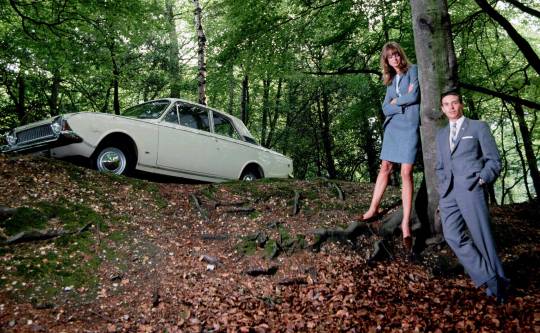
Clark won the first F1 championship race of the 1968 season in South Africa, where he beat Juan Manuel Fangio’s all-time record of 24 world championship Grand Prix victories. He was well-placed to win more F1 races and maybe become champion again in 1968, but then came Hockenheim…
His Lotus 48 F2 car was up against a strong international field and Clark was running eighth after the first four laps. On the fifth lap the Lotus headed uphill out of the stadium section of the course and into the woods, was seen to twitch, and flew off the road into the trees. Though the cause of the accident was never established beyond all doubt, it’s likely that a rear tyre failed, possibly due to debris from a previous incident. The Lotus hit a tree, and Clark died from a broken neck and fractured skull. He was just 32.
The whole motor racing community was numb. At Brands Hatch the news was announced to a stunned crowd. Colin Chapman was so destraught he considered giving up motor racing for good. Chris Amon, one of the greatest drivers of his era, summed up the general mood among the drivers by saying if this could happen to Clark, “What chance have the rest of us got?”
The shockwaves from his death were felt not just in Europe, where Clark was a superstar in F1 and touring car racing, but also in the US. Clark had been denied victory in the Indy 500 in dubious circumstances in 1963 but returned, and dominated the race, in 1965 – becoming the first F1 World Champion to win at the Brickyard.
But for a few quirks of fate, Clark could have been F1 champion 1962-1963-1964-1965-1968 and might even have gone on to race and win in the slicks-and-wings era of the early 1970s, which brought two world titles for the Lotus 72. He was, without doubt, one of the greatest drivers ever to race in F1.
Family and community meant a lot to him: his gravestone in Chirnside lists his occupation as ‘farmer’ before ‘World Champion motor racing driver’.
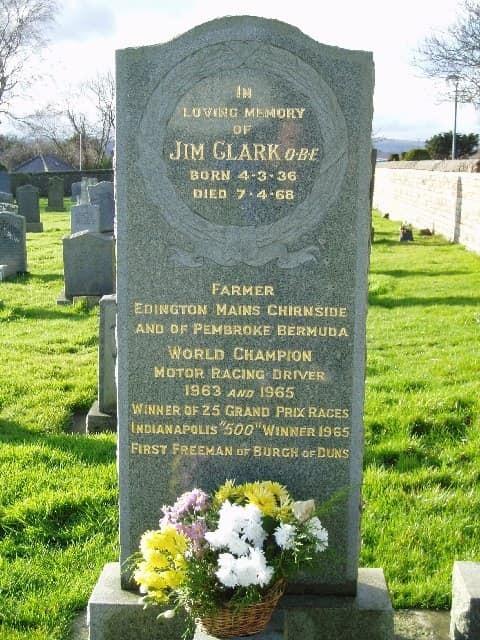
Jim Clark's grave in Chirnside, Scotland.

Jim Clark – winner 1968 Australian Grand Prix at Sandown, Melbourne.

In 1967, Lotus and Cosworth were reshaping the sport of Formula 1 with the assistance of Jim Clark and Graham Hill.

Jim Clark - Lotus 25 - French GP (1965)
French GP, Clermont Ferrand, 27 June 1965 .Winner Jim Clark, Lotus 33 in practice(he raced Lotus 25)
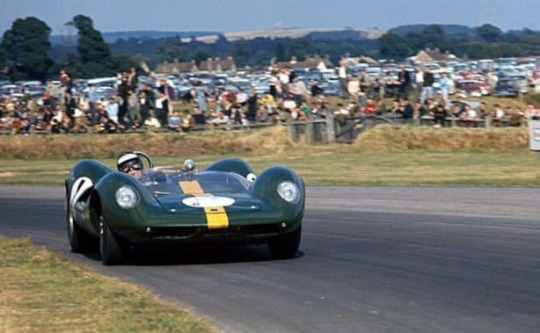
1964 Goodwood TT, Jim Clark, Lotus 30 Ford

The Flying Scotsman Jim Clark
90 notes
·
View notes
Text
What kind of car Leland Turbo is, why I think he was once/going to be a race car, and why this is objectively the sluttiest looking car
In this essay, I will—
So, right off the bat, this car does not exist :/

It’s a mosaic of features from real cars, but he is not a direct translation of a real car. Our pals over on fandom wiki list his car type as a “1965 Runwell-Type SR” but even they’re like yeah it’s completely made up.
Now, there are some cars that come very close to what Leland looks like. He’s obviously modeled after a c. 1960s Jaguar E-Type. But he doesn’t have a sloped back so that narrows the field down a bit more.

There were hard top convertible e-types in the ‘60s that bare a striking resemblance to our friend, Agent Turbo. And he could certainly be modeled after a car like this, but there’s another Jaguar that I think fits the mold a little better.

There was a jaguar e-type lightweight model that was made in the ‘60s as a race car.

It just feels a bit more solid than the run of the mill e-type and closer to Leland’s stockier silhouette. Of course there’s discrepancies. It doesn’t have the bumper trim pieces (but those were likely spy gadget add-ons anyway), the headlights are slightly different, the hood completely different, and the rear end as well.

(I struggle finding official reference photos of this bastard(affectionate) but we’ll work with what we’ve got) the break lights, center trim pieces, and rear window shape are all completely different from the e-types. I’m not familiar enough with other vehicles of this era to be able to place where those features were taken from or if they’re just made up. But overall, his base frame is the Jaguar, and I think the racing model fits that frame the best, which would also be a fascinating plot point if it had been incorporated into cars 2.
As for my finishing thoughts,

I rest my case.
#my pretentious ramblings#as if I know anything about cars XD#but I’m very proud of my half baked research#shhh I totally know what I’m talking about#cars2renaissance#leland turbo#cars 2 (2011)#cars 2#cars fandom
18 notes
·
View notes
Text
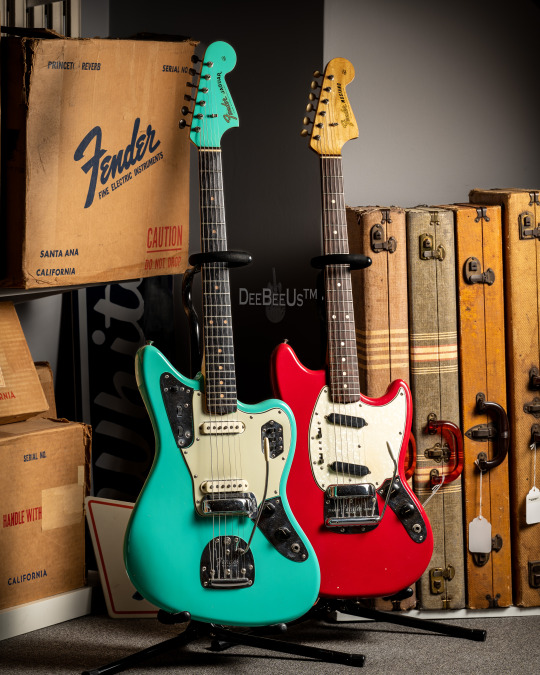
1964 Jaguar in (super rare) Foam Green & 1965 red Mustang in Red, both from the @terry_foster collection.
It's always a bit like drinking from a firehose visiting Terry's collection, and last night's visit was no exception. Terry is cooking up an article on an absolutely unique, one-of-a-kind piece of #Fender history for @fretboardjournal magazine, and asked me to snap a few photos. See Terry's story for some BTS content (you will get a hint of what the article will be about, and even get to see what I look like lol!)
If you don't know Terry Foster, you may have heard of the book he co-authored with Martin & Paul Kelly called "Fender The Golden Age 1946 - 1970", which is essential reading for any vintage guitar afficionado, and the definitive history of the Fender company during it's heyday.
If you *do* know Terry Foster, you will then also know that this photo shows some of the LEAST rare pieces in his vast collection of all things Fender. I can't even begin to describe the depth and breadth of the historical treasures Terry has gathered. He has gone lightyears beyond simply collecting Fender guitars and amps (although he has those too), into Fender ephemera of all types...from production prototypes to dealer signs and chachkas to historical company documents to plans and notes handwritten by company officers to business cards (some spanning specific employees' entire careers with Fender and beyond!) to Fender company Christmas Cards to unseen/unpublished personal photographs of, and taken by, Leo Fender. And this just scratches the surface...the list goes on, and on, AND ON! You have to see what Terry has to believe it, and it will boggle your mind. Hopefully he will write another book someday soon...
Anyhoo...after last night's mind-blowing collection tour, I am completely exhausted. I am going back to bed. Enjoy these lovely offsets for #fenderfriday!😂
#guitar#guitars#guitarphotography#fender#vintageguitars#electricguitar#vintagegear#stratocaster#jaguar#fender jaguar#mustang#fender mustang#offset#offset guitar#fender offset#fender the golden age#terry foster#vintage fender#fender guitars
92 notes
·
View notes
Text

Steve McQueen Raced This Rare 1965 Lola T70 at the Nürburgring. 2


This highland green 1968 Ford Mustang GT; the hero car driven by the King of Cool, Steve McQueen, in the iconic 1968 film Bullitt

Steve McQueen au volant d'une Shelby Cobra 427 Roadster 1963

Steve McQueen et sa Jaguar XKSS Roadster 1956 04
10 notes
·
View notes
Text

A Leopard 1A5 of PzBtl 183 passes a Raketenjagdpanzer Jaguar 1 ATGM carrier at Bergen, 1995.
The Leopard 1 is Germany's first widely produced tank after World War II, entering service in 1965 with the Bundeswehr. The 1A5 model notably features a new Krupp-Atlas Elektronik EMES 18 fire control system, equipping the Leopard 1A5 with thermal imaging and a laser rangefinder, useful at night and at longer ranges respectively.
The Raketenjagdpanzer Jaguar 1 on the other hand, just hardly seen in this photo, is an anti-tank missile carrier, using the Euromissile HOT missile in a foldout launcher. Notable with the Jaguar 1 seen in this photo is the presence of the new optics and thermal imaging system, the large box on the front of the vehicle. These were installed in the mid-1990s to all Jaguar 1s.
23 notes
·
View notes
Text

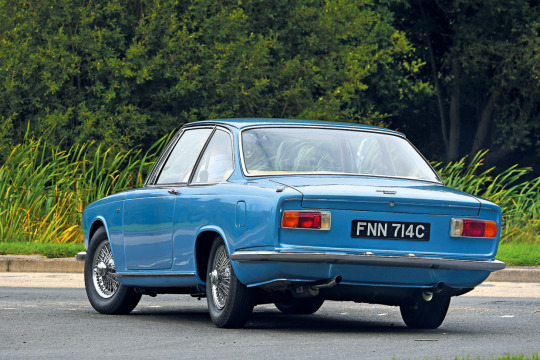

1965 Frua Jaguar S-Type
My tumblr-blogs: https://www.tumblr.com/blog/germancarssince1946 & https://www.tumblr.com/blog/frenchcarssince1946 & https://www.tumblr.com/blog/englishcarssince1946 & https://www.tumblr.com/blog/italiancarssince1946 & https://www.tumblr.com/blog/japanesecarssince1947
4 notes
·
View notes
Photo

Wendy O'Rourke on Twitter
Jane Birkin & John Barry in the infamous Jaguar E Type from the 1965 article in Newsweek that dubbed him the man "with the E-type Jag and the E-type wife."
58 notes
·
View notes
Text

Jaguar E-Type Series 1 1965. - source Auto Sales.
57 notes
·
View notes








